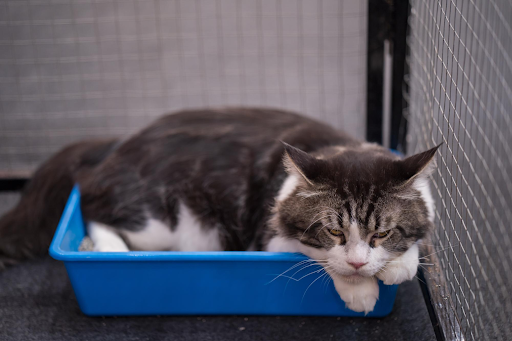Litter training your cat can be a long and tiring process. Here’s a detailed guide explaining everything you need to know:
Table of Contents
Importance of Litter Training a Cat
Before we dive into the basics of litter training, the question arises: Why do you need to litter train a cat? First off, it prevents indoor accidents and reduces the stress that comes with cat ownership. It also helps create a clean indoor environment, promoting the well-being of the entire house. The last thing you need is carpet stains and soiled sofas.
Litter boxes also allow you to monitor your cat’s urine and feces, which are common health indicators. Above everything, using a litter box aligns with a cat’s natural instincts. Cats are inclined to dig, scratch, and bury their waste. This is not possible with toilet training.
Pre-Training: Choosing the Right Litter Tray
Next, choose the right litter tray or box. Here’s everything you need to consider:
Size: The correct size of a litter tray depends on your cat. However, a good rule of thumb is to choose a tray 1.5 times the length of your cat. This provides enough space for your furry friend to dig and move.
Type: Open, low-sided trays are generally preferred for cats. If you have senior cats, you can go with a larger or deeper tray to give them enough room to move around.
Tray Material: Select a sturdy plastic tray that can withstand scratches.
Scoop: Invest in a sturdy and good-quality scooper to clean the litter.
Choosing the Right Litter
This is where many cat owners make mistakes. Each cat has its preferences, and the best way to find the right litter is through trial and error.
Common types of cat litter include:
- Dust-free litter
- Clumping litter
- Sand or clay
- Silica litter
Soft, small-grained litter is mostly used since it is easy to walk on. You can also opt for silica litter, as it ensures quick absorption. You can buy cat litter online from reputable brands.
Placing the Litter Box
This is one of the most overlooked aspects of litter training your cat. Many cat owners tuck the litter box away in basements or other little-used areas of the house.
Place the litter box in the hallway or in the corner of the family room. That being said, avoid choosing a high-traffic or noisy area, as cats like to eliminate in peace.
Lastly, make sure the litter box is positioned away from the cat’s food and water bowls.
Steps to Litter Train
Whether you’ve adopted a new kitten or are trying to train an older cat, here are three steps you need to follow:
Know the Signs
Timing is everything. Knowing when and how many times your cat usually poops or pees can help ease the process. For instance, adult cats typically need to poop every 12-24 hours, while kittens can poop 3-4 times a day. Every cat is different, so observe your cat’s habits before starting.
Sniffing, scratching their paws, and crouching on the floor are all common signs of a cat wanting to eliminate.
Introduce Your Cat to the Litter Box
When you spot the telltale signs, lift your cat and place them in the tray. Move away and give them space. Some experts also recommend confining your cat to a certain space to encourage them. With time, your furry friend will associate going to the toilet with the litter tray.
Praise Good Behavior
Positive reinforcement is critical for building good habits. So, after your cat has used the litter tray, give them a treat to show appreciation. By contrast, punishing your cat for not using the litter tray isn’t a good idea.
Importance of Cleaning the Cat Litter Box
To avoid accidents and unpleasant odors in your house, make it a habit to clean the litter box regularly. Cats like to live in a clean environment, so they won’t typically poop in a soiled litter box.
Clean out the soiled litter daily, or more often if necessary. Check the litter tray multiple times a day and clean anytime you see waste. Completely empty the tray and wash it with detergent at least once a week.
How Long Does It Take to Litter Train a Cat?
Every cat is different. While there is no one-size-fits-all approach, most cats take about 4-6 weeks to get used to the litter tray. Keep using positive reinforcement to encourage them.
Expect Accidents to Happen
Litter training your cat takes time. Being impatient or using punishment won’t get you results any faster. Moreover, remember that accidents can happen during the process.
On a side note, if you’ve already litter trained your cat but they’re urinating throughout the house, schedule a vet exam. This could be a sign of a urinary tract infection.








